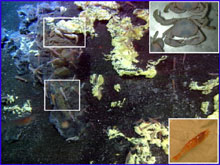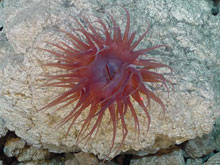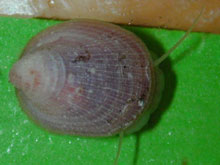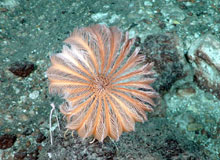
Small crabs (~4 to 10 cm) actively roam the venting area. Japanese biologists first discovered the crab species in the upper right inset on a seamount at the northern end of the Mariana Arc. Click image for larger view and more details.
An 'Unsafe Neighborhood' at NW Rota 1 and W Rota Volcanoes
April 2, 2004
Verena Tunnicliffe
Canada Research Chair in Deep Oceans
Professor, University of Victoria, Canada
![]() Two species of shrimp at the hydrothermal vents at NW Rota 1 volcano (mp4, 5.2 MB)
Two species of shrimp at the hydrothermal vents at NW Rota 1 volcano (mp4, 5.2 MB)
![]() Collecting an unusual species of shrimp found at the hydrothermal vent (mp4, 4 MB)
Collecting an unusual species of shrimp found at the hydrothermal vent (mp4, 4 MB)
In this early part of the cruise, the biological collections have posed more questions than they have answered. First, although we have seen a fairly large area of venting on NW Rota-1 volcano, the associated animal community is very limited. We are searching for clues to explain the low diversity and lack of colonization in some venting areas. We believe the area may to be too unstable to sustain a bottom assemblage. This cruise is a fine example of linking disciplines to interpret processes; in this case, the geologists are developing a scenario of a rumbling volcano with constant shifting of sediments and perhaps fluid conduits. Animals may find the neighborhood too dangerous.

A purple anemone (~6 inches across ~15 cm) clings to a pumice rock along the east crater wall of West Rota volcano. Anemones are suspension feeders, capturing zooplankton with their tentacles. Click image for larger view.

Limpets were seen grazing near the seeping fluids. They tend to form small clusters. This animal is probably an undescribed species related to a limpet that occurs on seamounts off Japan. The limpet is > ~0.5 inches (~1.5 cm). Click image for larger view.
So far, we have located four vent species on NW Rota 1. A small white crab is our first indication that vents are near. So far this species is known only on seamounts at the northern end of the Mariana Arc. It is related to another species found only a few miles from here, but in much deeper water (nearly 4,000 m) in the Mariana Trough vent sites. Depth is a major barrier to species dispersal. Judging from how the shrimp react, taking violent leaps as the crabs come near, they may be part of the crabs' diet. The shrimp may be a new species; expert examination is required. They cluster near shimmering water and appear to be scraping the rocks; bacterial mat is likely their main food. We hope to compare populations of this animal on different seamounts as the cruise progresses. Two more animals are also likely to be new species: a large limpet and a scale worm. Both occur on the edges of vents. New species are always useful as they provide information for systematists trying to understand the relationships among species at seeps and vents in the deep sea.

A stalked crinoid (~5 inches across, ~13 cm) rests on the caldera sea floor at West Rota volcano. Crinoids are suspension feeders, using their crown, which is covered with sticky pinnules, to capture zooplankton. Click image for larger view.
We have encountered many animals that are not living at the vents. On older outcrops of rocks, turbulence tends to supply plankton to feed animals such as anemones, soft corals, and hydroids. Last night we saw some exotic stalked crinoids. These sea lilies covered the ocean floor about 400 million years ago. Now, only a few species remain in the deep sea.
Sign up for the Ocean Explorer E-mail Update List.



























